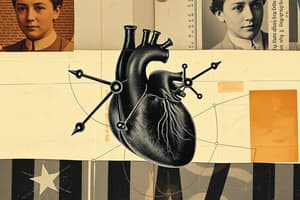Podcast
Questions and Answers
Diltiazem is classified as what type of medication?
Diltiazem is classified as what type of medication?
- Angiotensin-converting enzyme inhibitor
- Calcium channel blocker (correct)
- Sodium channel agonist
- Beta-adrenergic antagonist
Diltiazem is used to treat which of the following conditions?
Diltiazem is used to treat which of the following conditions?
- Migraines
- Glaucoma
- Osteoporosis
- Angina pectoris (correct)
What is the primary mechanism of action of diltiazem?
What is the primary mechanism of action of diltiazem?
- Inhibiting the production of cholesterol
- Stimulating beta-adrenergic receptors
- Blocking calcium channels in cardiac and vascular smooth muscle (correct)
- Enhancing sodium influx in nerve cells
What effect does diltiazem have on heart rate?
What effect does diltiazem have on heart rate?
How is diltiazem primarily metabolized in the body?
How is diltiazem primarily metabolized in the body?
A contraindication for diltiazem is:
A contraindication for diltiazem is:
A common side effect of diltiazem is:
A common side effect of diltiazem is:
Diltiazem can increase the levels of which drug, potentially leading to toxicity?
Diltiazem can increase the levels of which drug, potentially leading to toxicity?
What should be monitored regularly during diltiazem therapy?
What should be monitored regularly during diltiazem therapy?
Which of the following is a symptom of diltiazem overdose?
Which of the following is a symptom of diltiazem overdose?
Flashcards
What is Diltiazem?
What is Diltiazem?
A benzothiazepine calcium channel blocker used to treat hypertension, angina, and certain arrhythmias.
Diltiazem's action?
Diltiazem's action?
Diltiazem blocks calcium channels in cardiac and vascular smooth muscle, reducing intracellular calcium.
Diltiazem's effects?
Diltiazem's effects?
Vasodilation (↓BP), reduced heart rate, slowed AV node conduction, and decreased myocardial contractility.
Diltiazem Pharmacokinetics?
Diltiazem Pharmacokinetics?
Signup and view all the flashcards
Diltiazem indications?
Diltiazem indications?
Signup and view all the flashcards
Diltiazem contraindications?
Diltiazem contraindications?
Signup and view all the flashcards
Common Diltiazem side effects?
Common Diltiazem side effects?
Signup and view all the flashcards
Diltiazem drug interactions?
Diltiazem drug interactions?
Signup and view all the flashcards
Diltiazem monitoring?
Diltiazem monitoring?
Signup and view all the flashcards
Diltiazem overdose?
Diltiazem overdose?
Signup and view all the flashcards
Study Notes
- Diltiazem is a benzothiazepine calcium channel blocker medication
- Used to treat hypertension, angina pectoris, and some types of arrhythmia
Mechanism of Action
- Blocks calcium channels in cardiac and vascular smooth muscle
- Reduces intracellular calcium
- Decreased calcium influx causes relaxation of vascular smooth muscle, leading to vasodilation and reduced blood pressure
- Decreases heart rate through slowed SA node automaticity
- Slows AV node conduction
- Decreases myocardial contractility
Pharmacokinetics
- Administered orally and intravenously
- Rapid oral absorption, limited bioavailability due to first-pass metabolism
- Metabolized in the liver by cytochrome P450 enzymes
- Metabolites are excreted in urine and feces
- Half-life is approximately 3-9 hours, which can be prolonged with chronic use or in patients with liver impairment
Indications
- Effective for lowering blood pressure by vasodilation for hypertension
- Reduces frequency and severity of angina attacks by decreasing myocardial oxygen demand for angina pectoris
- Controls heart rate in SVT by slowing AV node conduction
- Slows ventricular response in atrial fibrillation and atrial flutter
Dosage and Administration
- Dosage varies based on indication and individual factors
- For hypertension:
- Start with 60-120 mg twice daily for sustained-release formulations
- Adjust dosage based on blood pressure response
- For angina:
- Start with 30 mg four times daily or 60 mg three times daily for immediate-release formulations
- Sustained-release formulations are available
- For SVT:
- Administer an IV bolus of 0.25 mg/kg over 2 minutes, followed by continuous infusion
- Initiate oral maintenance therapy after acute control
- Available in immediate-release tablets, extended-release capsules, and intravenous solutions
Contraindications
- Hypersensitivity to diltiazem or its components
- Sick sinus syndrome or AV block (without a functioning pacemaker)
- Hypotension (systolic blood pressure < 90 mmHg)
- Acute myocardial infarction with pulmonary congestion
- Concurrent use with intravenous beta-blockers
Adverse Effects
- Common side effects:
- Headache
- Dizziness
- Bradycardia
- Hypotension
- Peripheral edema
- Constipation
- Less common but serious adverse effects:
- AV block
- Congestive heart failure
- Liver enzyme elevations
- Allergic reactions
Drug Interactions
- With Beta-Blockers: May cause excessive bradycardia, hypotension, and heart failure
- With Digoxin: Can increase digoxin levels, potentially leading to toxicity
- With Antiarrhythmics: Increased risk of arrhythmias
- With Statins: Can increase statin levels, raising the risk of myopathy
- With Immunosuppressants: Can increase levels of cyclosporine and tacrolimus
- CYP3A4 Inhibitors/Inducers: Affect diltiazem metabolism and levels
- Grapefruit juice may increase diltiazem levels
Special Populations
- Use during pregnancy only if the potential benefit justifies the risk to the fetus
- Diltiazem is excreted in breast milk; caution is advised during breastfeeding
- Elderly patients may be more sensitive to hypotensive effects
- Dose adjustments may be necessary for renal impairment
- Dose adjustments are necessary for hepatic impairment due to reduced metabolism
Monitoring
- Monitor blood pressure and heart rate regularly, especially during initial therapy and dose adjustments
- Monitor ECG in patients with arrhythmias or those at risk of AV block
- Monitor liver function tests periodically, especially in patients with liver disease or those taking other hepatotoxic drugs
- When used concurrently with digoxin, monitor digoxin levels
- Assess renal function periodically, especially in patients with renal impairment
Overdosage
- Symptoms:
- Hypotension
- Bradycardia
- AV block
- Heart failure
- Treatment includes:
- Supportive care, including IV fluids and vasopressors for hypotension
- Atropine for bradycardia
- Calcium gluconate to reverse calcium channel blockade
- Cardiac pacing for severe AV block
Studying That Suits You
Use AI to generate personalized quizzes and flashcards to suit your learning preferences.
Description
Explore diltiazem, a benzothiazepine calcium channel blocker used for hypertension, angina, and arrhythmias. Learn about its mechanism of action, which involves blocking calcium channels to relax vascular smooth muscle and reduce heart rate. Understand its pharmacokinetics, including oral and intravenous administration.



